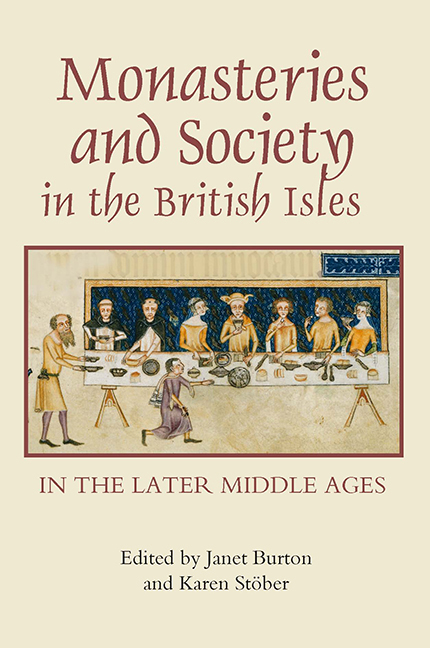Book contents
- Frontmatter
- Contents
- List of illustrations
- Acknowledgements
- List of contributors
- Abbreviations
- Introduction
- The Meeting of the Worlds
- Religious Houses and their Patrons and Benefactors
- 5 Patronage, prestige and politics: The Observant Franciscans at Adare
- 6 The Augustinian priory of Wombridge and its benefactors in the later Middle Ages
- 7 The rising price of piety in the later Middle Ages
- Female Communities: Nuns, Abbesses and Prioresses
- Monasteries and Education
- Monasteries and Urban Space
- Religious Houses in the Regions
- Index of Religious Houses mentioned in the text
- Index
- Miscellaneous Endmatter
5 - Patronage, prestige and politics: The Observant Franciscans at Adare
from Religious Houses and their Patrons and Benefactors
Published online by Cambridge University Press: 24 October 2017
- Frontmatter
- Contents
- List of illustrations
- Acknowledgements
- List of contributors
- Abbreviations
- Introduction
- The Meeting of the Worlds
- Religious Houses and their Patrons and Benefactors
- 5 Patronage, prestige and politics: The Observant Franciscans at Adare
- 6 The Augustinian priory of Wombridge and its benefactors in the later Middle Ages
- 7 The rising price of piety in the later Middle Ages
- Female Communities: Nuns, Abbesses and Prioresses
- Monasteries and Education
- Monasteries and Urban Space
- Religious Houses in the Regions
- Index of Religious Houses mentioned in the text
- Index
- Miscellaneous Endmatter
Summary
The village of Adare in Co. Limerick is one of the principal tourist attractions in the south-west of Ireland. The efforts of the local landlords, the Wyndham- Quin earls of Dunraven, in the late nineteenth century produced a picture postcard streetscape more reminiscent of the Cotswolds than of rural Ireland. At the heart of the village lies a remarkable ensemble of medieval ecclesiastical and secular buildings dating from the village's heyday as the manorial caput of the Fitzgerald earls of Kildare. The Fitzgeralds gained possession of the manor in the early thirteenth century and it remained theirs until it was forfeited to the earls of Desmond, following the Kildare rebellion in 1534. The surviving structures consist of the Fitzgerald or Desmond castle, constructed at various stages between the thirteenth and fifteenth centuries; the thirteenthcentury parish church of St Nicholas; a monastery of Trinitarian friars founded by Geoffrey de Marisco in the early thirteenth century and now serving as the Roman Catholic parish church; a house of Augustinian friars founded in 1316 by James Fitz Thomas Fitzgerald, first earl of Kildare, and now the Anglican parish church. In the fifteenth century a chantry chapel was established adjacent to the parish church and in 1464 a friary was established for Observant Franciscans by Thomas Fitzgerald, seventh earl of Kildare, and his countess, Johanna, daughter of James Fitzgerald, the seventh earl of Desmond. This last foundation is unique in Ireland in that documentary, testamentary and architectural evidence disclose a pattern of patronage that demonstrates the close symbiotic relationship between the friars and the leading figures of the Anglo- Irish and Gaelic elites.
The Franciscans in Ireland
The establishment of the Irish Franciscan province by the general chapter of the Friars Minor at Assisi in 1230 formally brought Irish church and society into contact with one of the most vibrant and creative movements in the late medieval church. As was the case elsewhere in Europe, the Franciscans in Ireland underwent a period of rapid expansion and, by 1325, when the first wave of foundations ceased, thirty-two friaries had been established. The pioneers of the Irish province were for the most part Englishmen who naturally gravitated to the towns and boroughs of the Anglo-Norman colony.
- Type
- Chapter
- Information
- Publisher: Boydell & BrewerPrint publication year: 2008



